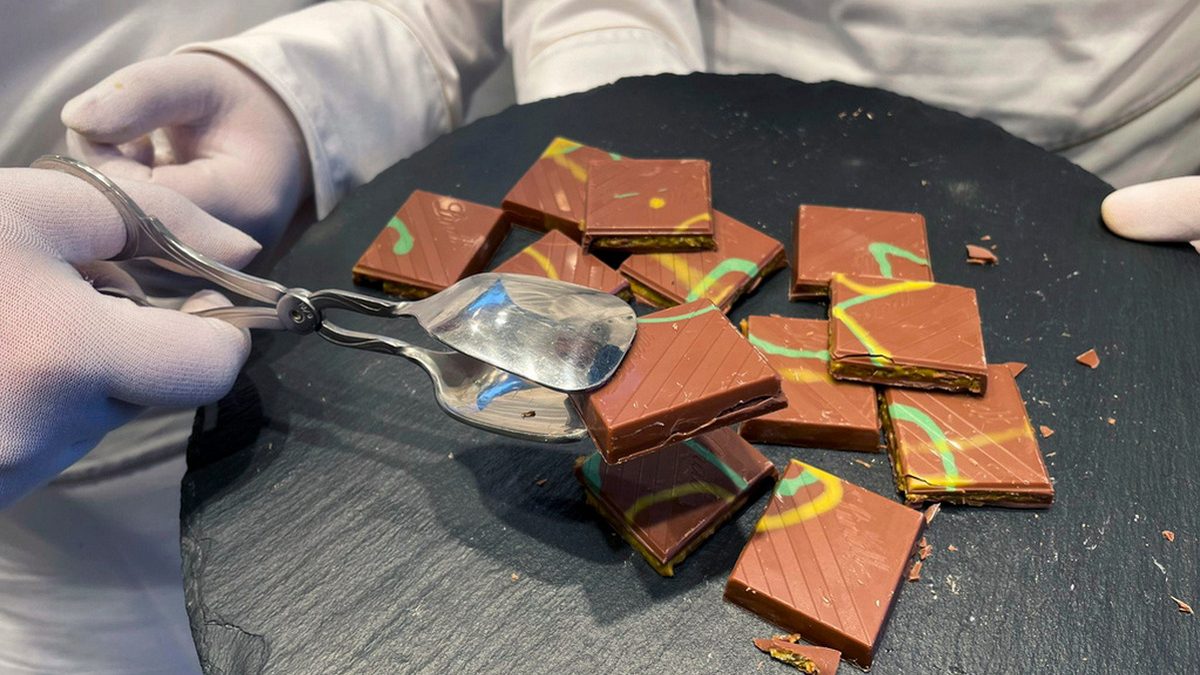A chocolate from Dubai that went viral has caused a frenzy in Germany.
The so-called ‘Dubai chocolate’ has been launched by Lindt in Germany as well as some bakeries – with customers queuing up for hours to get their hands on it.
But what do we know about the chocolate? How has it caused a stir in Germany?
Let’s take a closer look
What do we know about it?
It was invented in 2021 by British-Egyptian entrepreneur Sarah Hamouda, who is based in Dubai.
It comprises a blocky, hand-decorated chocolate bar with various quirky fillings –- the signature flavour being a rich pistachio cream.
The treat went viral after TikTok food influencer Maria Vehera posted a video of herself eating a bar in her car.
It has since been viewed more than 100 million times.
The real thing is only available to local customers in limited quantities, but the trend has led to an explosion of copycat versions of the chocolate around the world.
When Ali Fakhro lays out a row of pistachio-filled chocolate bars in the morning at his bakery in Berlin, he knows they will be gone in a matter of hours.
Inspired by the viral success of the crunchy delicacy known as “Dubai chocolate”, Fakhro, 32, hunted down a recipe and began making his own version two months ago.
Impact Shorts
More ShortsFakhro, who runs Abu Khaled Sweets in Berlin, experimented “several times” with different recipes before finally landing on the right ingredient to give the pistachio cream its famous crunch – a finely shredded Middle Eastern pastry known as kataifi.
“On the first day I made 20 bars, but they went fast. The next day, I made 50 – all gone too,” he said.
How has it caused a stir in Germany?
Germans have been scrambling to get their hands on the chocolate with bars selling for over $104 on the internet.
Last week, a 31-year-old man was caught by customs attempting to smuggle 45 kilograms of the sweet treat into Germany from Switzerland.
When Swiss manufacturer Lindt launched its own version of the Dubai chocolate in Germany this month, customers queued for hours in the cold to get their hands on a bar.
According to The National, some even bought camping and wet weather gear to stand outside the Lindt store in Aachen.
“It’s a hype, a trend on social media, with people waiting in long lines,” Zi Cheng Lai, 23, a student from Malaysia living in the city, told the newspaper. “We want to try it out here and be part of it.”
“It’s juicy inside but also crunchy, I think it’s the strands of the angel hair,” student Esko Rieck added.
Rieck queued up outside the store for hours.
“I’m here because I’ve never been at such a release event and I wanted to experience the release of a limited edition.”
Lindt launched the chocolate in Germany with 1,000 numbered bars in 10 shops, a spokesman for the group told AFP, and is planning a similar launch in Austria on November 30.
At up to 20 euros per bar, the delicacy is far more expensive than your average chocolate bar – but that didn’t seem to be putting anyone off.
“I waited 10 hours. I’ve been here since midnight just to taste this chocolate,” 18-year-old student Leon Faehnle told AFP outside a Lindt shop in Stuttgart.
Yannick Burkhard, 21, queued for three hours in Stuttgart to get his hands on the chocolate – but is not planning to eat any of it himself.
Instead, he will sell it on the internet.
“This bar cost 15 euros, but it can sell for almost 100 euros… There are lots of offers on eBay, up to 300 euros,” said a customer who gave his name only as Lucas, 24.
Faehnle had a more wholesome plan for his bars as he exited the shop in Stuttgart beaming with pride at his purchase.
“Now I’m going to go home and share them with my grandparents,” he said.
Experts say this development can only be a positive for the market on a whole.
“It’s a good thing if more people start to like chocolate and regularly eat chocolate – it expands the market in places like Asia and the Middle East,” Roger Wehrli, the director of ChocoSuisse, told The National.
With inputs from agencies


)

)
)
)
)
)
)
)
)



